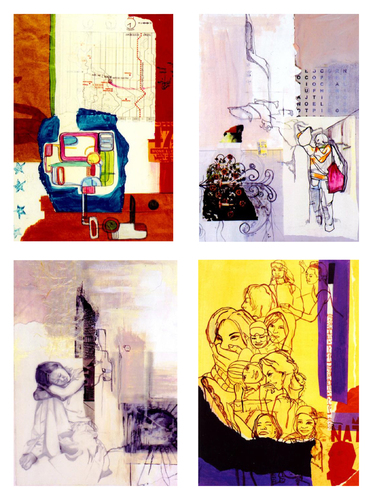TEACHING PHILOSOPHY

Sigh
collage series
Junko Ikeda, Art Honors course
The Visual Voice:
Pedagogy for Image Making
Gretchen Beck, M.F.A.
As a professor of two-dimensional image making, I enjoy designing a curriculum for studio art classes. Giving my students freedom within structure and encouraging an on-going dialogue between concept and form enables them to convey their ideas in their imagery. This approach to teaching results in students producing mature work. For my classes, I use a five-step approach, which includes developing a theme, creating preliminary sketches to form a final image, participating in peer critiques, engaging in spontaneous exercises and revising imagery. The ultimate goal of this pedagogy is to empower every student with a distinct visual voice.
Envisioning a Theme
To begin the image making process, I show my students the work of significant artists to stimulate their imaginations and to cultivate a connection between art history and their creativity. The students then study their surroundings to discover subject matter that interests them. After brainstorming in the classroom with their ideas, they develop strong themes to convey in their work. Once the students decide on their topics, they investigate by drawing from life and taking photographs as resource material. I find that real learning takes place when they discover content they care about. At the same time, the students continue to study other artists’ work through research they conduct at the library.
Preliminary Sketches that Lead to a Final Image
Once they gather enough reference material, students produce a series of thumbnail sketches. When they have arrived at strong compositions, they begin preliminary drawings which serve as bases for completed artwork. With the particular media the students employ, they create final images.
Peer Critiques
The students in my classes then engage in peer critiques to discuss their art pieces. For this exercise, each student works with a friend and answers a series of questions related to the techniques and ideas they have been exploring. The students offer suggestions about the images they analyze. After responding in written form, the artists then share their thoughts with each other. The exchange of ideas becomes public and each pair of students discusses their own work and that of their friends in front of the class. Throughout this part of the critique, the other class members can ask questions and respond to the work being discussed. This exercise creates a sense of trust in the classroom and stimulates a dialogue where students look forward to presenting their imagery to each other.
Igniting a Sense of Play
As a contrast to this process and to remind students of the serendipitous and intuitive aspects of image making, I also introduce them to exercises that ignite a sense of play in their work. This comes about through a variety of forms such as sketching on the sidewalk with water to create ephemeral drawings, producing a tableau that a class could use as subject matter for a composition, or making quick monoprints to spur on new ideas for artwork. Engaging students like this keeps the artistic process fresh and alive for them.
Grading and Revision
I grade the students’ art by responding to the conceptual and technical qualities of their images. With my suggestions and the feedback they receive in the critique, the students then refine their work. This entire process enables them to construct strong compositions, to think critically about visual strengths and problems and to articulate the formal qualities of an image. They learn to take ownership in every part of the picture plane. Though the journey to the final product is long, students find great satisfaction and pride in the completed work of art.
Exposing Student Work to the Greater Community
The exhibitions in a university gallery are designed to complement the course offerings in the art department. In my experience, students in all of the art classes attend and then respond to the exhibitions and lectures in essay form. They often share their papers in class and discuss the influence of an artist’s work long after an exhibition is completed.
Student art expositions also adorn the gallery at the end of each semester, and throughout the academic year their artwork hangs in the art department. To display their imagery in a show, art students help choose the strongest work that has been produced throughout the semester. The selected artists develop creative titles for their pieces, write artists’ statements that discuss the conceptual and technical qualities of their projects and present their work in a professional manner. Thus the gallery program serves as a vital part of my pedagogy.
The Role of Art in the Journey of Life
As an art educator, I see myself as a guide who helps students travel individual journeys that will shape their careers as artists, curators and teachers. Imagination, wonder and hard work come together to empower students to develop a life-long repertoire of artistic processes and methods of working.








